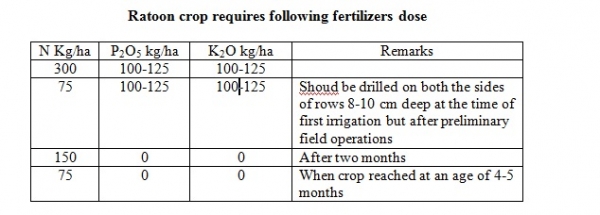Ratooning of the cane is an age-old practice in all sugarcane growing countries.
About 35 to 40 % of total sugarcane cultivated area each year covered under ratoon crop in India and Gujarat. Normally, one or two ratoon is permissible in most of the states. However, in certain states, only one ratoon is recommended. The second or more subsequent ratoon is not advised because of the risk of pest and diseases.
Following points/cares to be taken into consideration for obtaining maximum yields from ratoon crop
• Improved varieties for ratton crop. All the recommended varieties except Co-C 671 are suitable for ratoon crop.
• Selection of time for ratooning.
1. When main crop is harvested during November to February should be selected for ratoon crop.
2. But when main crop is harvested during April - May should not be selected for ratooning because of less time available for better growth and development and ultimately yields are reduced. So it is not advantageous to take ratoon crop from late harvested main sugarcane crop.
• Other cares
1. Main crop should be harvested as close to the ground level as possible.
2. Earthing up should be done to avoid lodging which occurs due to wind and heavy rainfall.
3. Generally tillers are emerged out after harvesting of main crop, if these tillers are not removed in time cause not to mature sugarcane crop uniformly at same time so that early tillers should be removed at the time of taking ratooning crop. These may helps in emergence of all tillers at a time and crop may mature at the same time.
4. After harvesting of main crop, field should be cleaned by removing leaves and other small stalks pieces left on the field.
5. Gap filling - After preliminary field operation, the gap filling should be done by transplanting of one or three budded seedlings raised well in advance in nursery before first irrigation or with rooted slips from excess tillers of the same field or by using new sugarcane setts.
6. Top dressing - the ratoon crop required more nitrogen than main crop because sugarcane crop stands on the same field for about 22 to 24 months altogether.

7. Irrigation - In deep and more moisture retentive soils, the first irrigation should be given 25 to 30 days after harvesting of fresh crop/main crop/first crop. While in light types of soils, the first irrigation should be given 15 to 20 days after harvesting of main crop.
8. In South Gujarat area, if ratoon crop is taken for the first time requires 14 irrigations.
9. While in middle Gujarat and Saurashtra region, normally irrigations are given more frequent 10 to 15 days interval according to the structure and depth of the soils,
10. Two to three interculturing and two to three hand weeding are required for effective control of weeds. Light earthing up should be carried out 2 to 3 months (i.e. after second top dressing) and heavy earthing up is done with the help of ridger at the time of last top dressing.
Advantages of ratoon crop
• No need of land preparation and layout which reduce the cost of production.
• Due to saving of time behind land preparation, ratoon crop get sufficient time for better growth and development.
• It saves the cost of planting and seed materials.
• The ratoon crop matures about one month earlier than fresh crop.
• The recovery of sugar and Gur is obtained more, which reduced the cost of sugar production and increase income.
• One or two ratooning reduces about 25 % cost of cultivation.

